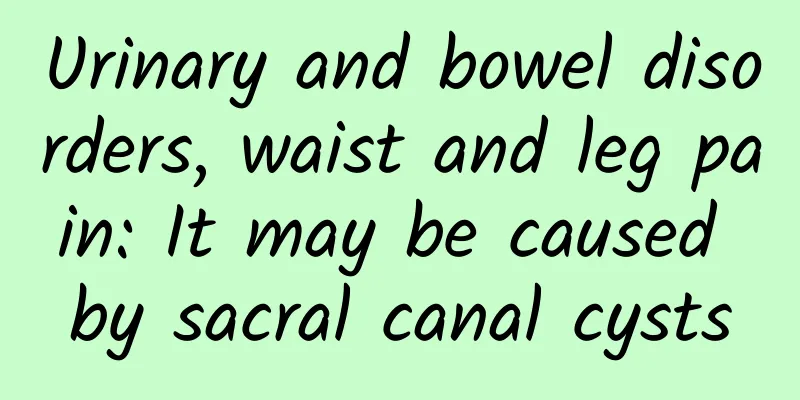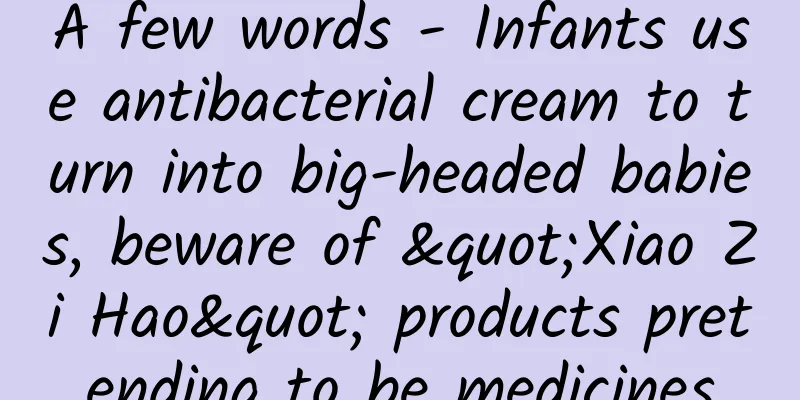Urinary and bowel disorders, waist and leg pain: It may be caused by sacral canal cysts

|
Ms. Yang, 55 years old this year, has been suffering from back and leg pain for 6 years. In the past few years, she has been to many hospitals accompanied by her husband to seek medical treatment, but they were all diagnosed and treated as lumbar disc herniation, and the pain has never been relieved. More than half a year ago, Ms. Yang began to suffer from urinary and bowel disorders, especially after each urination, she always had a lot of urine and had to wear a baby diaper. This had a great impact on her normal work, life and psychology, and even caused anxiety and depression. When seeing this worried lady, Associate Professor Chen Xiaofeng, member of the Spine and Spinal Cord Professional Committee of the World Chinese Medical Association, member of the Neuro-Oncology Professional Committee of the Chinese Anti-Cancer Association, and leader of the Spinal Cord and Spine Medical Group of the First Affiliated Hospital of Harbin Medical University, conducted a detailed physical examination and completed relevant physical and chemical examinations. He also invited the gynecology, urology, and orthopedics departments to conduct a multidisciplinary consultation and discussion. Based on Ms. Yang's pain symptoms and urination disorder characteristics, as well as the results of various examination reports, it was finally confirmed that her condition was caused by a sacral canal cyst located in the center of the sacrum at the caudal end of the spine. The expert consultation opinion was that Ms. Yang's clinical symptoms and signs were all caused by the sacral canal cyst, and conservative treatment would certainly not be easy to improve or relieve. It was recommended to monitor with the help of the "third eye" of neuroelectrophysiology during the operation to ensure that the nerve function was not damaged, and to perform "partial cyst wall resection + nerve root cuff plasty" on her. After sufficient preoperative preparation, the surgeon Chen Xiaofeng peeled and removed the cyst under direct microscope. The operation was completed in two hours, with less than 10 ml of intraoperative bleeding, and the surrounding nerve tissue remained intact. The buried "landmines" were cleared, and Ms. Yang's problems of low back pain and difficulty in defecation were also solved. How does a sacral canal cyst come about? Professor Chen Xiaofeng introduced that the sacral canal is located inside the sacrum below the waist. It is a dura mater cyst that originates from the spinal cord membrane, so it is collectively called "intraspinal meningeal cyst". Clinically, sacral canal cysts are not a single cyst, but include multiple types such as perineurial cysts, meningeal cysts, meningeal diverticula, and arachnoid cysts; cysts are mainly single, with a few being multiple, and the most common site of onset is the sacral 2-3 area. Clinically, the vast majority of patients with early sacral canal cysts do not have obvious symptoms and are only discovered accidentally during routine imaging examinations. Since the widespread use of magnetic resonance imaging, the detection rate of sacral canal cysts has become increasingly higher, which has also caused great concern among patients. In fact, sacral canal cysts always occur "quietly" and are easy to be confused and misdiagnosed. In Dr. Chen Xiaofeng's clinic, patients with low back pain or dysuria are often transferred to orthopedics, urology, pain medicine, traditional Chinese medicine and other departments. Some are diagnosed with herniated disc, lumbar muscle strain, spinal stenosis, or thought to be caused by urinary tract infection. Acupuncture, physical therapy, traction or minimally invasive surgery are ineffective, and finally a clear "answer" is found in neurosurgery. In fact, such patients only need to undergo an MRI scan to identify the crux of the problem. So, how are sacral canal cysts formed? It is generally believed that it is related to congenital developmental abnormalities and acquired secondary trauma, inflammation, etc. Dr. Chen introduced that among the many academic viewpoints on the formation and development of sacral canal cysts, the "ball valve mechanism" theory gives a more reasonable explanation, that is, there is a potential, closed subperineural space between the perineurium and the endoneurium, and usually the subperineural space and the subarachnoid space "go their own way". When the hydrostatic pressure of cerebrospinal fluid increases, such as coughing, standing, increased abdominal pressure, and arterial pulsation, it will cause cerebrospinal fluid to flow into the cavity between the perineurium and the endoneurium. Due to the involuntary communication between the subperineural space and the subarachnoid space, over time, a one-way "valve" will be formed at the junction of the two, preventing the cerebrospinal fluid from flowing back along the original route, making it difficult to discharge and forming a cyst. Intervene early when symptoms are severe Generally speaking, most sacral canal cysts have no obvious clinical symptoms, but about 10-20% of patients will experience pain, numbness and decreased muscle strength in the buttocks, saddle area and lower limbs. Severe cases may lead to difficulty in urination and defecation and sexual dysfunction, which is clinically called "symptomatic sacral canal cyst". This is because the cyst compresses, pulls and twists the cyst-bearing nerve roots or the surrounding nerve roots, which in turn causes numbness and soreness in the lower limbs and difficulty in urination and defecation. At the same time, because the cyst erodes the sacrum, it enhances the sensitivity of the periosteal receptors, thereby amplifying the pain in the waist and perineum. It should be emphasized that if the above symptoms are aggravated when sitting up, walking or coughing, the possibility of a sacral canal cyst should be considered. Once a sacral canal cyst is diagnosed, how should it be treated? Chen Xiaofeng suggested that for some patients with symptomatic sacral canal cysts, conservative treatments can be chosen first, including the use of analgesics, nonsteroidal anti-inflammatory drugs, physical therapy, massage, etc.; if conservative methods are ineffective, the pain in the waist and legs is aggravated and accompanied by lower limb muscle strength, sensory dyssentuation, perineal pain or sensory loss, urinary or sexual dysfunction, further surgical intervention can be considered. For simple sacral canal cysts, the cyst can be simply removed and the leak ligated; for nerve root cysts, it is appropriate to perform partial cyst wall removal + nerve root cuff plasty under electrophysiological monitoring. Bad living habits need to be changed Dr. Chen Xiaofeng emphasized that although the word "swelling" is in the word "sacral canal cyst", it is not a real tumor and has no possibility of canceration. Please rest assured. In a word, as a common disease in neurosurgery, sacral canal cyst usually develops insidiously and is difficult to be absorbed or disappear on its own. There is no need to have too much psychological pressure. If the symptoms are obvious, it can be eradicated through minimally invasive surgery. Finally, Professor Chen kindly reminded that whether or not to have surgery, patients should pay attention to the following points in their daily lives: do not sit or stand for long periods of time. If you sit or walk for a long time, you should take a break, lie down or lie on the bed. Even when you are outdoors, you should take a proper posture to relax. Sitting for too long can easily make the sacral canal cyst "blown" like a balloon. You should also keep warm and avoid catching cold. Do not often bend over to do heavy physical labor or carry heavy objects. At the same time, you should try to change your eating habits of "not loving spicy food" because onions, ginger, and peppers can easily induce coughing or strong choking, which will increase abdominal pressure, affect the sacral canal, and make the cyst inside more "expanded". If you have to cough, try to lie down before coughing. Introduction of Professor Chen Xiaofeng Chief physician, master's supervisor, head of the spinal cord and spine medical group of the Department of Neurosurgery, the First Affiliated Hospital of Harbin Medical University, doctor of medicine, and postdoctoral fellow. Part-time academic positions: Member of the Spine and Spinal Cord Professional Committee of the World Chinese Medical Doctors Association, Member of the Neuro-Oncology Professional Committee of the Chinese Anti-Cancer Association, Standing Committee Member of the Pain Branch of the Heilongjiang Medical Health Care International Exchange Promotion Association, and Vice Chairman of the Heilongjiang Physical Rehabilitation Committee. Clinically, we are good at minimally invasive treatment, including microsurgical treatment of intraspinal tumors (such as neurilemmoma, meningioma, ependymoma, glioma), cervical disc herniation, lumbar disc herniation, pituitary tumor, meningioma, hemifacial spasm, trigeminal neuralgia, glioma and other brain and spinal cord diseases with cervical, thoracic, low back and leg pain or weakness. We focus on minimally invasive treatment, embody the concept of accelerated recovery after surgery, and promote early recovery of patients. He has published 8 SCI articles and 1 core journal article as the first author; he has successively won 1 National Natural Science Youth Fund, 1 Heilongjiang Provincial Health Commission project, 1 Heilongjiang Provincial Postdoctoral Fund and 1 Harbin Medical University First Hospital Doctoral Fund; he won 1 second prize for scientific and technological progress from the Chinese Medical Association; he won 1 first prize for scientific and technological progress from the Chinese Anti-Cancer Association; he was awarded the honorary title of Outstanding Scientific Researcher of Harbin Medical University First Hospital; he participated in the editing of academic monographs such as "Essentials of Diagnosis and Treatment of Cranial and Brain Tumors", "Essentials of Diagnosis and Treatment of Critical Cases in Neurosurgery", and "Color Atlas of Clinical Pathology of Brain Tumors" published by the People's Medical Publishing House; he also served as the deputy translator of "Emergency Medicine" and the chief editor of "Orthopedics" published by the People's Medical Publishing House, and completed the translation and publication of 12 original medical monographs in the same series. |
<<: What is purple cabbage? How to eat purple cabbage
>>: Will eating too much popcorn make you get angry? Who is not suitable to eat popcorn?
Recommend
The difference between endometrial cancer stage 1 and 1a
Stage 1 endometrial cancer is a common gynecologi...
What festivals do we drink chrysanthemum wine on? What are the origins of chrysanthemum wine?
During the Double Ninth Festival, Chinese people ...
Irregular menstruation is not necessarily a gynecological disease
Irregular menstruation may be caused by diseases ...
Will the water stop flowing after it breaks?
To put it simply, rupture of water is the dischar...
What brand is the ring given by the second male lead in Crash Landing on You? How much is the same engagement ring as Son Ye-jin's in Crash Landing on You?
In the latest episode of "Crash Landing on Y...
How long does it take for the uterine wound to heal after cesarean section?
Compared with natural birth, cesarean section has...
What is a safe and effective breast augmentation method?
Women all hope to have full breasts, but there ar...
What does pelvic cystic mass mean?
When we feel unwell, we need to undergo a lot of ...
What should I do if my period hasn't ended for more than ten days?
Menstrual disorders are common among women. There...
Will the fetus stop growing in late pregnancy?
For pregnant women in the late stages of pregnanc...
[Fat Bear Science] Why do we need to do CT or MRI after color Doppler ultrasound to diagnose some diseases? Can't one test do the job?
Doctor, I have a lot of lumps on my neck! Go get ...
Ovarian development chart of girls
Whether a woman's ovaries are strong or not h...
The correct way to dry your bra
The overall appearance of the bra is very beautif...
Can I do plank during menstruation?
Plank is an exercise that many women like to do. ...
What is the cause of blood streaks in early pregnancy?
There are many issues that women need to pay atte...









